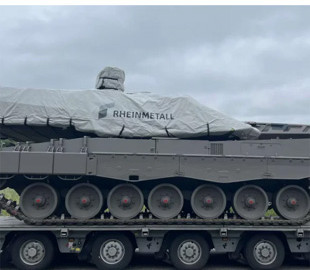
According to the Meumeu Twitter account, Rheinmetall tanks were on their way to the Eurosatory 2024 exhibition in France. Among these vehicles is a new hybrid model that combines a Leopard 2A4 chassis with a KF51 Panther turret equipped with a 130 mm gun. There are several possible uses for this hybrid tank: it could be a prototype for the future Leopard 2AX, a solution for upgrading existing Leopard 2 fleets, or a competitor to the MGCS and E-MBT.
One hypothesis is that the integration of the KF51 turret into the Leopard 2A4 chassis is part of Rheinmetall's strategy to offer an upgrade path for countries operating Leopard 2A4 tanks, similar to other projects around the world. For example, Turechynna integrated the turret of the new Altay tank and armor into her Leopard 2A4. The Canadian Leopard 2A4M CAN includes additional composite and lattice armor, an upgraded fire control system and advanced thermal imaging. The upgrade in Chile, managed by Aselsan, includes advanced opto-electronic systems, a new fire control system and defense improvements, including laser warning systems and potential active defense systems. Austria is also upgrading its Leopard 2A4s with improved protection and electronic systems.
Another hypothesis is that this hybrid tank is a new evolutionary step in the Leopard 2 series, potentially leading to a model called the Leopard 2AX. This upcoming variant of the Leopard 2 series will be the next generation, after the Leopard 2A8.
This model is expected to include a hybrid powertrain and advanced protection systems based on the technology of its predecessors. The Leopard 2AX is intended to serve as a transitional platform for more advanced main battle tank concepts. This new prototype may indicate that Rheinmetall is combining proven elements of the Leopard 2 series with KF-51 Panther technologies to offer improved lethality, targeting systems and operational flexibility for the future Leopard tank, potentially creating the future Leopard 2A9.
Another hypothesis is that the introduction of this hybrid model is a strategic move to position Rheinmetall's products as a competitive alternative to the Advanced Main Battle Tank (E-MBT), which also has a hybrid design that combines elements of two existing tanks, namely the German Leopard 2A7 and the French Leclerc. Like the KF51 Panther, the E-MBT has a two-man turret and autoloader, reducing crew size and increasing efficiency. In addition, the advanced features and modular design of the KF51 Panther turret may have capabilities comparable to these next-generation tanks, including the Franco-German Main Ground Combat System (MGCS), allowing countries to modernize their Leopard 2 fleets more quickly and cost-effectively.
In addition, the hybrid tank can be designed to maintain interoperability with NATO and allied forces using the Leopard 2 series and shared logistics, maintenance and operational procedures. Finally, Rheinmetall's broader technological approach is evident in this design, focusing on digital systems integration, advanced weaponry such as the 130mm Rheinmetall Future Gun System, and improved multi-layered protection with the Leopard 2A4 chassis, benefiting from proven mobility and durability .
KF51 Panther
The KF51 Panther turret offers a wide range of armaments: its main weapon, the 130mm Rheinmetall Future Gun System (FGS), is said to outperform the standard 120mm NATO guns. The FGS provides a 50% longer effective range, implying a strike distance that can potentially exceed 4 kilometers. The gun is equipped with an automatic loader that provides a rate of fire of approximately 11.25 rounds per minute thanks to conveyor magazines that hold ten rounds each. During testing, the automatic loader demonstrated the ability to fire three shells in 16 seconds. The FGS can fire a variety of munitions, including Kinetic Energy (KE) projectiles such as Armor Penetrating Fin Stabilized Projectiles (APFSDS) to penetrate enemy armor, Programmable Air Burst munitions effective against infantry and light vehicles with programmable fuzes for optimal detonation , and practical equipment for educational purposes. Thanks to these features, the Panther can face a wide range of threats on the battlefield.
The main armament is a 12.7-mm twin machine gun designed to engage infantry, light vehicles and other light targets. This machine gun is coaxially mounted, meaning it is aligned with the main gun and integrated into the same aiming systems. This integration allows the crew to switch between primary and secondary weapons, increasing the tank's versatility and speed of response in combat situations. The 12.7mm machine gun provides additional firepower in situations where the use of the main gun is unnecessary or impractical, providing a full range of engagement capabilities.
The KF51 Panther offers Remote Controlled Weapon Station (RCWS) options, including configurations such as the Rheinmetall Natter RCWS armed with a 7.62mm machine gun. These systems are designed for close defense and anti-drone operations, providing a critical level of protection against emerging threats. Natter RCWS is capable of climbing in the range of -15° up to +85°, which provides a wide range of aiming angles, including aerial threats. This flexibility ensures that the Panther can defend itself against a variety of close-range and aerial threats, increasing its overall battlefield survivability.
The KF51 Panther is equipped with HERO 120 ammunition, increasing its striking capabilities. These munitions extend the tank's ability to engage targets beyond line of sight, providing accurate hits at long distances. The HERO 120 can be launched from a tank to engage high-value targets, providing indirect fire support and complementing the main gun's direct fire capabilities. This integration of ammunition in combat allows “Panther” hit a wider range of targets, including those that are hidden or located at a distance, thus increasing its operational effectiveness and versatility in various combat scenarios.

